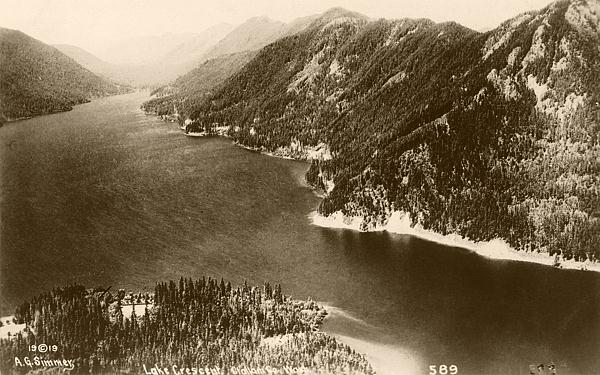Spruce Production Division
Railroad No. 1

Spruce Production Division Railroad No. 1 was constructed in 1918 along the north side
of Lake Crescent by government contract and by U.S. Army spruce squadrons, from the
Spruce Production Division of the U.S. Army Signal Corps. The railroad was
constructed for the transport of Sitka spruce logs to be milled for the manufacture of
wood-frame World War I airplanes. The above scene, photographed in 1918, shows
soldiers posing proudly with their axes on the Lake Crescent right-of-way. Note the two
crossed axes, a symbolism similar to the crossed axe and crosscut saw on the emblem
at the bottom of this page. The railroad was completed for a total of 36 miles, with 33
miles having 80-pound rail and 3 miles having 67½-pound rail. The
67½-pound rail was very unusual in that it was Russian rail, originally
manufactured to be sent to Russia during the war. The railroad was only completed as
far as Lake Pleasant, a few weeks before the war ended, but it was originally planned
to continue farther west and to make over a 20-mile loop on the west end of the line.
Despite the ambitious endeavor and great expense, not a single log was hauled for the
wartime effort.

This scene by Alfred G. Simmer, photographed in 1919, shows the grade cut for the
Spruce Production Division Railroad No. 1, shortly after completion of construction.
Note in the photograph that the railroad grade was tunneled through a portion of
the point at the narrow part of the lake. This tunnel was known as the Daley-Rankin
Tunnel and was the shorter of two railroad tunnels located along the lake. The other
tunnel, the longer McFee Tunnel, was constructed less than two miles down the tracks
at Devil Point. The railroad was purchased by Lyon, Hill & Company in 1923 and
then by the Sol Duc Investment Company in 1925, which incorporated the railroad in
1925 as the Port Angeles Western Railroad. The railroad hauled logs for several
different companies, but mainly for the Crescent Logging Company, which held a major
interest in the Sol Duc Investment Company. The Port Angeles Western Railroad
operated until 1950, before being formally abandoned in 1953. The peak on the far
right side of the photograph is named Pyramid Peak and it was previously named
Sugarloaf Mountain.

This scene, probably photographed in mid to late 1918, shows the loading of
spruce logs in Clallam County by a Spruce Production Division crew. This location
would have actually been along Spruce Production Division Railroad No. 2, as that
railroad was completed from Pysht, Washington in May 1918, about six months before
WWI ended. The logs shown were up to about nine feet in diameter and were hoisted
onto railroad skeleton cars using the steam donkey yarder visible in the background.

This scene shows the mill constructed by the Spruce Production Division in 1918
on the west side of the mouth of Ennis Creek, along the Strait of Juan de Fuca, at
Port Angeles, Washington. Ennis Creek is named after the former S'Klallam
village of I'e'nis (I-eh-nus), which once was located by the mouth of Ennis
creek. The mill was about seventy percent complete and had cost about three-quarters
of a million dollars when the armistice was signed on November 11, 1918 and
construction ceased. The mill was planned to have had two band head saws and also
a cut-up plant with six cant saws for sawing straight-grained spruce from cants and
flitches. The production capacity was expected to be one million board feet per day.
Another mill was planned to have been built at Lake Pleasant, along the upper (western)
part of Spruce Production Division Railroad No. 1. The Lake Pleasant mill would have
been as large as the Port Angeles Mill, except its cut-up plant would have only had four
cant saws. Additionally, a small commercial mill at Lake Pleasant with only one circular
head saw was purchased by the government for construction purposes.

Akin to the army Spruce Production Division was the civilian Loyal Legion of Loggers
and Lumbermen (LLLL), which engaged timber workers in the production of spruce
material for airplane construction. Three of the total of thirteen
Spruce Production Division
railroads were located on the Olympic Peninsula. Spruce Production Division
Railroad No. 1 was known as the Clallam County Railroad. This railroad extended
westward beginning at Disque Junction located 17.6 track miles west of Port
Angeles on the Seattle, Port Angeles & Western Railway (formerly the Seattle,
Port Angeles & Lake Crescent Railway). Shortly after WWI ended, the Seattle,
Port Angeles & Western Railway Company became the Olympic Division of the
Chicago, Milwaukee and St. Paul Railway. From Disque Junction, Spruce Production
Division Railroad No. 1 ran up the Lyre River drainage through the Lyre River canyon
and proceeded along the north shore of Lake Crescent and then through the Sol Duc
Valley to Lake Pleasant. Spruce Production Division Railroad No. 2 was known as the
Merrill and Ring Railroad. This railroad extended westward for about five miles from
Pysht and was an extension of a railroad that was already owned and operated by
Merrill and Ring. Spruce Production Division Railroad No. 3 was known as the
Quinault Railroad and was located in northern Grays Harbor County. This railroad was
built for about five miles by contract with the Polson Logging Company and was also
surveyed about four miles into the Quinault Indian Reservation and partially cleared by
the time the armistice was signed.
<< BACK
 Andrew Craig Magnuson
Andrew Craig Magnuson
Forks, Washington
April 14, 2007
Copyright © by Andrew Craig Magnuson
|